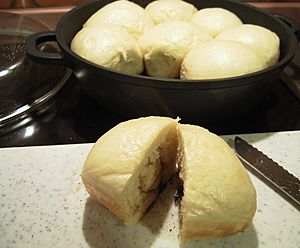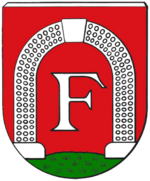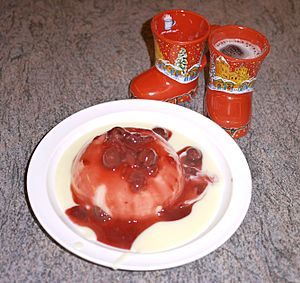- This page was last modified on 17 October 2025, at 10:18. Suggest an edit.
Dampfnudel facts for kids
 |
|
| Type | Sweet bread |
|---|---|
| Place of origin | Germany and Alsace |
| Main ingredients | Flour, water, yeast, butter or margarine; sometimes eggs or sugar |
A Dampfnudel (say "Dampf-noodle") is a special kind of white bread roll. It's soft and fluffy, almost like a dumpling, and it's cooked by steaming. You can eat it as a main meal or as a sweet dessert.
This tasty dish is very popular in southern Germany, Austria, and in the Alsace region of France. The name Dampfnudel literally means "steam-noodle" in German.
A Sweet Story from History

The Coat of arms of Freckenfeld, which features the Dampfnudel gate.
The Dampfnudel has a cool story from a long time ago! There are special gates called Dampfnudel gates in two towns in western Germany: Freckenfeld and Kandel. These towns are close to the French border.
During a big war called the Thirty Years' War, some Swedish soldiers came to Freckenfeld. They demanded a lot of money and goods from the town. But a clever baker named Johannes Muck had an idea. With his wife and helper, he quickly baked 1,286 Dampfnudeln! They offered these warm, delicious rolls to the hungry soldiers. The soldiers were so happy with the food that they decided to leave the village alone. They didn't take anything else or cause any trouble.
Because of this event, the Dampfnudeltor (Dampfnudel gate) is even shown on the coat of arms of Freckenfeld. It's a symbol of how food saved their town!
How Dampfnudeln are Made
Dampfnudeln are made from a simple dough. The main ingredients are white flour, water, yeast, salt, and butter or margarine. Sometimes, people also add eggs and a little bit of sugar to make them sweeter.
Here's how they are made:
- First, the dough is mixed and kneaded.
- Then, it's shaped into small balls, about the size of an egg or a fist.
- These dough balls are left to rise, which means they get bigger and puffier.
- Finally, they are cooked in a special closed pot, usually a deep pan with a lid.
There are two main ways to cook them:
- In Bavaria, they are cooked with milk and butter.
- In the Rhineland-Palatinate region, they use salt water and fat.
As they cook, a golden-brown crust forms on the bottom of the Dampfnudel when the liquid dries up. But the tops stay white and soft because they are cooked by steam!
How to Eat Dampfnudeln
Dampfnudeln can be eaten in different ways, either as a main meal or as a dessert.
- As a main course: People often eat them with savory (not sweet) side dishes. Some popular choices include:
* Cabbage * Salad * Gherkins (small pickles) * Potato soup or lentil soup * Mushrooms in a creamy béchamel sauce
- As a dessert: If you prefer something sweet, Dampfnudeln are delicious with:
* Vanilla custard * Jam * Boiled fruit
Even though they can be sweet, in places like Bavaria and the Palatinate, Dampfnudeln are traditionally served as the main dish, even if they are served with sweet toppings!
See also
 In Spanish: Dampfnudel para niños
In Spanish: Dampfnudel para niños


